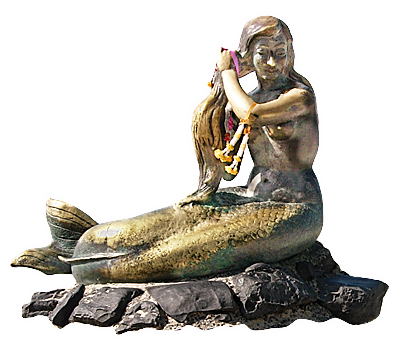
City and Province of Songkhla
Although Songkhla is one of the oldest cities of Thailand, it changed it's position in the past repeatedly. The contemporary city of Songkhla is now placed on a peninsula between Songkhla Lake (Thale Sap Songkhla) and the Gulf of Thailand. This settlement dates back to 1842.
Songkhla, Panorama
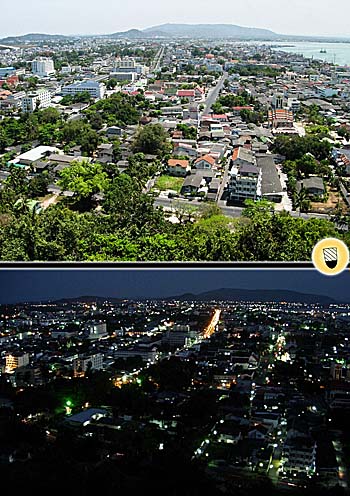
View from Khao Tank Kuan Pagoda Hill to the west over Songkhla city. Images and photocomposition by Asienreisender, 2005, 2015
Songkhla is not only a southern Thai city but also a province capital with the same name. The much bigger city of Hat Yai, south Thailand's central traffic hub west of Songkhla city, is part of the province.
Songkhla's economy is based on fishing in the brackish waters of the Songkhla Lake, Thailand's largest lake, in the Gulf of Thailand and on rice production. It's said there were still a small population of Irrawaddy Dolphins living in the lake. Since the shores of the lake are coined by the fishing industries with the dirt and smell who are typical for them, the eastern shores are coined by long, attractive sand beaches. Namely Samila Beach (Hat Samila) is a large and deep sand beach where casuarina trees (Asian pine trees) grant shade against a pricking sun. A number of beach restaurants offer seafood and comfortable seats under colourful umbrellas. At Hat Samila's northeastern corner is a mermaid placed, which reminds very much to the mermaid in Kopenhagen/Denmark, although the Thais see her as Mae Thorani, the earth goddess who protected the meditating Buddha when he was under attack of Mara's daemons. Close to the beach are the two small islands Ko Nu and Ko Maew (mouse and cat island). Nevertheless, there are not many tourists visiting the place.
Songkhla's Beaches
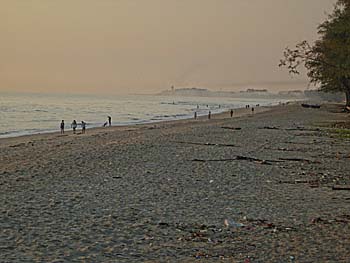
An early morning stroll along Songkhla's long beaches. Thai People are used to get up early as well. Particularly in hot countries the morning is the best time of the day. Image by Asienreisender, 2005
The northwestern continuation of Samila Beach is also sandy and widely deserted. It's a longer stretch and a nice walk until the end. The way along the lakeside is paralleled by a road. This furthest end of the peninsula of Songkhla is covered by sandy ground and a small casuarina forest.
There were a number of American and British experts living in town at my last visit, who worked for multinational corporations exploring the coastline for offshore oil fields. They earn a good deal of money and bring some wealth to the place.
Although Songkhla core city has only less than 69.000 inhabitants (in 2012), decades of growth made the urbanization stretching out along all the bigger and smaller, the older and new roads, but particularly along the main road to Hat Yai. In fact, the city is part of the so called 'Greater Hat Yai - Songkhla Metropolitan Area'. So, the small place appears nowadays quite busy with too much traffic, noise and pollution, and too much new concrete towards all directions. In the past there was also a railroad connection to Hat Yai, but it got closed in 1978.
Colonial Shop Houses in Songkhla
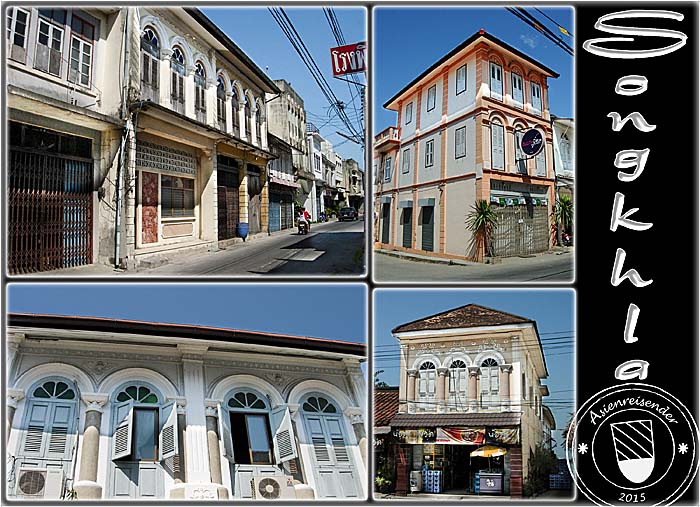
Interesting to find colonial shop house architecture in Songkhla, although the place was never under a European colonial regime. Certainly some Chinese saw that in Penang, Malacca, Singapore and other colonial places in the countries around and adapted it here. Images and photocomposition by Asienreisender, 2005, 2015
History of Songkhla
Already in the bronze age, some 3,000 years ago, people settled around the Songkhla Lake. Indian merchants and fishermen settled down here in the first or second century CE. An early port city was established, which was probably a post on the sea route between India and China, as Funan in the Mekong Delta was as well. In the 9th century Mahayana buddhism was introduced; after the downfall of the Srivijaya empire on Sumatra in the 12th century the people here converted to Theravada buddhism.
On a Thai Night Market
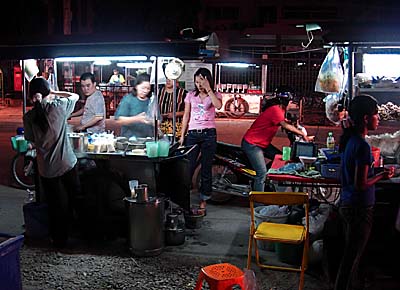
Thai food is legendary, and Thailand's night markets are very rich in a variety of different food, much of it of good quality. Image by Asienreisender, 2005
Around 1605 CE a Persian muslim nobleman called Mogol (Dato Moghal) fortified a town named 'Hua Khao Daeng' at the coast here. He ruled as the sultan of Singora (or Singhala, city of lions, similar to Singapore). However, the place was a vassal of the mighty Siamese empire of Ayutthaya. It developed well and became a successful competitor for the neighbouring port towns of Nakhon Si Thammarat and Pattani. Trade ships from Europe and Japan visited the duty-free port and brought considerable wealth. Mogol's son, sultan Sulaiman, declared independence from Ayutthaya in 1642 and triggered a series of attacks from the Siamese empire on Singora. In 1680, after 38 years of hostility, the Siamese conquered the town and destroyed it completely, including the harbour.
In these years there was a strong French influence in Ayutthaya (see also Simon de la Loubere's 'Depiction of Siam' and the article on Lopburi). The Greek adventurer Constantine Phaulkon, who was a trustee of Ayutthaya's king Narai, offered the place to the French East India Company in 1685 to build there a fortress and a trade post. However, the French declined the offer, because after the 1680 conquest of the place it was totally destroyed and therefore the French considered it useless.
The Port of Songkhla
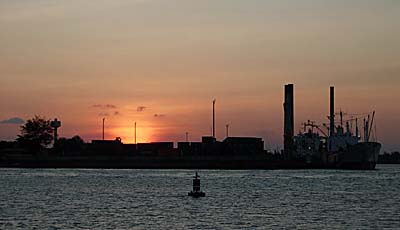
Songkhla's importance lies since centuries in it's status as a port town. Image by Asienreisender, 2005
In the following time the place was incorporated into the province of Phattalung and later to Nakhon Si Thammarat. It lost importance after the coup against king Narai and the isolationist phase of Siamese history after 1688. Over the time Songkhla grew again, this time dominated by Chinese traders. The first post-Ayutthaya Siamese king Taksin declared the Chinese Chin Yiang Sae Hao, patriach of an influential Chinese family, as governor of a new province of Songkhla in 1775. For the next 126 years, over eight generations, the governor's office remained in the hands of the same family. What is now the National Museum of Songkhla (since 1953) was the governor's home/palace in the late 19th century, built in 1878.
Khao Tang Kuan - The Royal Pavilion
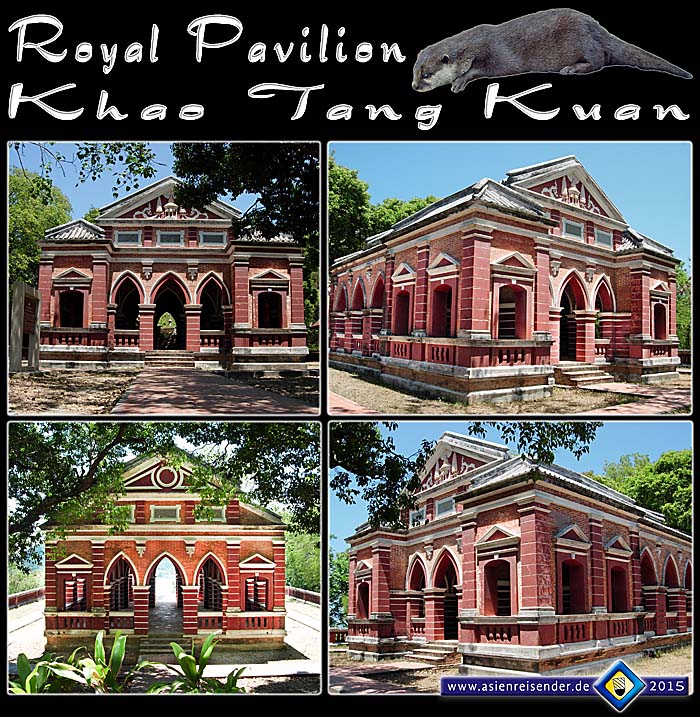
A surprising piece of architecture is the royal pavilion at the slope of Khao Tang Kuan, a hill or small mountain inmiddle of the city. It's a late 19th century building and goes back to an idea of the Siamese king Chulalongkorn (Rama V). The building combines very different styles. In the years of my visit 2005/2009/2010 it was empty.
The photo top left shows the entrance front, the one below the other side.
Few people come along here, so the place looks, although tidy, abandoned. Instead of people, a large population of macaques lives in the forest which coveres the hill. Down at the parkings Thai People frequently feed them. They suppose it brings them a good 'kharma'.
The otter above lived in Songkhla Zoo, 2005.
Images and photocomposition by Asienreisender, 2005, 2015
Chinese Shrine
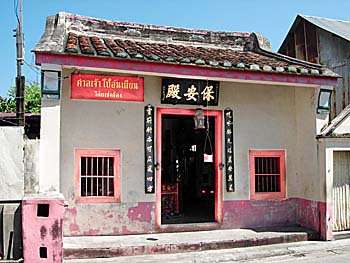
A small Chinese sanctuary in Songkhla city. Chinese influence is here, as everywhere in Thailand, large. Image by Asienreisender, 2005
In the Second World War the Japanese army attacked Thailand on the 8th December 1941, almost the same time as the attack on Pearl Harbor/Hawaii happened. Songkhla was one of the invasion points on their way to conquer the Malay Peninsula. There was short, but heavy fighting in Songkhla, and parts of the city were destroyed.
Population
The province of Songkhla borders to Pattani, one of Thailand's southernmost provinces who are in a state of civil war. There is an ethnic border between the both. Although Songkhla city is dominated by a vast majority of Thai buddhists, south of the city the population is mostly muslim with rather Malay roots. In total the province's population is by about 23% muslims.
The heritage of Chinese immigrants in Songkhla is large, but it's not exactly to quantify, because the Chinese are over generations often so well integrated into Thai society.